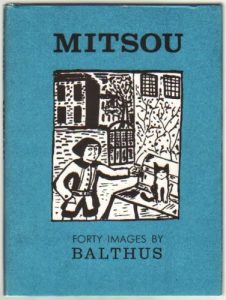“Trouver une chose, c’est toujours amusant; un moment avant elle n’y était pas encore. Mais trouver un chat, c’est inouï! Car ce chat, convenez-en, n’entre pas tout à fait dans votre vie, comme ferait, par exemple, un jouet quelconque tout en vous appartenant maintenant, il reste un peu en dehors, et cela fait toujours: la vie + un chat, ce qui donne, je vous assure, une somme énorme. Perdre une chose, c’est bien triste. Il est à supposer qu’elle se trouve mal, qu’elle se casse quelque part, qu’elle finit dans la déchéance. Mais perdre un chat: non! Ce n’est pas permis.”
“Finding a thing, that‘s always fun; a moment before it was not there yet. But finding a cat, that’s incredible! For this cat, admit it, does not come entirely into your life, as would for example any toy while belonging to you now. It remains a little off, and it always will be: a life + a cat, that adds up to a huge sum, I assure you. Losing a thing is very sad. It has to be assumed that it is in bad condition, that it breaks somewhere, that it ends in decay. But losing a cat: no! That is not allowed.”
A boy finds a stray cat, adopts it and gets more and more attached to it. The two spend a lot of time together and we see them in many everyday situations and small adventures. Then, Mitsou, the cat, disappears again; cats are doing this sometimes, so we don’t need to suspect the worst. But the boy is inconsolable, searches for Mitsou everywhere, but to no avail.
A sad but everyday story of a heartbreaking loss. What makes it extraordinary is the fact that this real-life experience was made into a series of beautiful drawings by the 11-year old boy to whom it happened. Balthasar Klossowski, today known as Balthus, told this story 1919 in 40 drawings that show an already fully accomplished artist. Cats and girls proved to be his lifelong artistic interests. (His brother Pierre was a also a talented painter and a writer.) Stylistically, the drawings resemble woodcuts and a certain influence of the Flemish artist and book illustrator Frans Masereel, who at around the same time published several “novels without words”, can be detected.
Rainer Maria Rilke, who was at that time the lover of Balthus’ mother Baladine, added a foreword in French when Mitsou was first published in 1921 and from which the above quote is taken. Therefore the review is not included in German Literature Month. (Rilke wrote also occasionally poems in French.)
Mitsou is a very charming and beautiful book. When you love cats or when you just want to enjoy a book with beautiful illustrations, you will like this precious work very much.
Art historian Sabine Rewald, author of the book Balthus: Cats and Girls describes here how she tracked down the surviving complete set of original drawings that were shown for the first time in an exhibition at the Metropolitan Museum of Art in New York not long ago. You can see also some samples of these wonderful drawings when you click on the hyperlink.
The English edition of the book is out of print, but you can find this gem with a bit of luck in antiquarian bookstores or online shops. The French and German editions are still available.
Mitsou. Forty Images by Balthus. Preface by Rainer Maria Rilke, translated by Richard Miller, The Metropolitan Museum of Art/Harry N. Abrams, New York 1984
Sabine Rewald: Balthus: Cats and Girls, The Metropolitan Museum of Art, New York 2013
The Rilke quote in this blog post is translated from French by Thomas Hübner.
© Thomas Hübner and mytwostotinki.com, 2014-5. Unauthorized use and/or duplication of this material without expressed and written permission from this blog’s author and/or owner is strictly prohibited. Excerpts and links may be used, provided that full and clear credit is given to Thomas Hübner and mytwostotinki.com with appropriate and specific direction to the original content.




 Facebook
Facebook RSS
RSS Twitter
Twitter